
The Flotillas of Hope was a voyage by two yachts carried out in 2004 by protesters critical of the Australian government’s asylum policy. The boats sailed to Nauru, a Pacific island nation which was host to Australia’s offshore immigrant detention center until the new Labor government came to power in 2007. They intended to deliver goods to those interned (most detainees are families who fled conflict in Afghanistan and Iraq), but not surprisingly were not allowed to land by the Nauruan government. Under an agreement put into effect earlier that year, Australia had taken responsibility for the island’s finances and civilian police force. John Howard, the Australian Prime Minister at the time, forced the Nauru government to take armed Australian Police Force to “protect” the island nation from the Flotillas of Hope flying Teddy Bear flags. The Flotillas of Hope project had two intentions 1) to give the refugees caged on the Island of Shame – Nauru, hope – that they have not been forgotten by people, that the Pacific Solution – out of sight, out of mind, did not work and 2) to bring the world media spotlight on Nauru on World Refugee Day, 20 June 2004. This the project achieved and it saw the granting of asylum to over half the refugees on Nauru and the release of Aladdin Sisalem who was in solitary confinement on Manus Island, New Guinea while we were sailing to Nauru.

Hand made flags with messages of hope and love made by the people of Australia flew on Eureka and One Off.
The way the Flotillas grew from an idea, a dream that manifested at first as an email Call to Action using the internet as a nervous system which then as an organsim, gathered into the Flotillas intention – satellite mobile phones, life rafts, high frequency radios, laptops, generators, sun power inverters, flags painted by community hands, dolls and teddy bears in handmade clothes, knitted sweaters, a large canvas sail painted by local Sydney artists along with other paintings expressly made and auctioned to raise money for the safe passage of the Flotillas of Hope, all of this and more occurred during the event.. From the finer embedded world of qualities, the realm of hope, love, justice, freedom – the realm of the spirits, the realm of creation, the Flotillas sparked into the internet. It was Art – in – Action using the world wide web to manifest. Hope was generated in not only the refugees caged on Nauru, but also in all people of good will who felt despondent that nothing will change the government’s heartless policy.

Trade Union Choir singing at the launch of the Flotillas of Hope in Sydney, 15 May, 2004.
Along the way, to the launch of the Flotillas, musicians performed live gigs to raise money for the project. There was a theme song written, performed and recorded along with poems about the Action. Check out Ernesto Presente’s poem on Poetry for Change website here. The lyrics of the Flotillas of Hope Theme Song is below. You can download the song here. You can also check out Joanna Leigh’s myspace profile here.

University students made videos. At the send – offs from Sydney, Newcastle, Coffs Harbour, Byron Bay and Brisbane, the Flotillas of Hope gathered the communities wishes and intentions to bring Hope to the refugees in the concentration camp of Nauru. The Flotillas did this by accepting hand made toys, hand made clothes for the dolls and teddy bears, the drawings and paintings of love and hope by Australian children, hand made flags with hand written words of love and hope from the people of Australia and overseas who sent gifts by post. Communities made beautiful flags – one with a Mandala made under the direction of a Buddhist priest, another of a Teddy Bear made by people who cared.

Poster promoting the departure of the flotillas from Brisbane.
On route to Nauru, the Flotillas docked at Santa Cruz Island, a far flung island of the Solomon Islands. The local indigenous people were so touched by our intention and by how far we had sailed and were sailing that they carved a beautiful wooden oar and gave it us to symbolize that they were rowing all the way with us to Nauru. They gave us the gift on the day we departed Santa Cruz with a send off that included singing, dancing, eating and words of power and encouragement.
The Flotillas carried the cargo of hope through the 12 mile No Go Zone and got to within 500 metres of Nauru coast until they were chased out by 6 Nauruan boats. The boats, Eureka and One Off became living talismans of peaceful and compassionate energies from Australians.
On the way to Nauru, refugees were freed and the websites designed to be the communications hub of the project informed the world about what was happening. There were live interviews with ABC, SBS, BBC, NZBC, Houston Radio, USA along with commercial radio and TV in Australia. A filmmaker, Angela van Boxtel made a Lucid Launch Flotillas of Hope website where artists contributed their art on the website. The Flotillas of Hope was an idea that touched people from across the world and it was an effective art action in all its levels of manifestation.
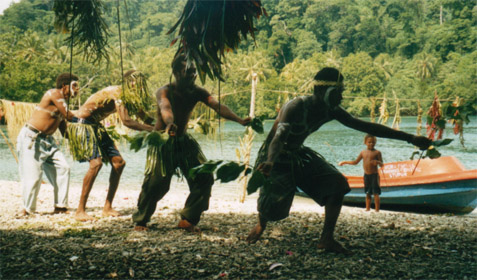
Santa Cruz, Solomon Islands locals dancing at the departure ceremony.

Santa Cruz, Solomon Island dancers at the departure ceremony wishing us luck and grace.

Various artists painted sections of this canvas sail which was auctioned off along with other original works of art in Gallery 179, Darlinghurst to raise funds for the Flotillas of Hope..
It was also an expression of the newly coined word “Noopolitics” which encompasses Pierre Teilhard de Chardin’s concept of the noosphere of knowledge / information (Teilhard is often called the patron saint of the Internet) because we not only made the news, we also reported the news which was transmitted across the world wide web and TV, radio and text media through our logs and the live satellite phone hookups with global media. The narrative of the journey was transmitted live by the logs of the crew.
The crew received messages of hope – poems and passionate prose from people all over the world who sent text messages from the web directly to our sat – phone in the middle of the deep blue sea. People following the journey on the web were informed as to the exact location of the boats by maps updated by satellite phone to the communications cluster. The project has been archived at the Australian Maritime Museum.
Artists that contributed the sections on the Sail are in order from the top to the bottom, left to right: Dale Dean, Euan Macleod, Mareia Brozky, Angelica Greening, Ingrid Skirkia, John Bell, Lorna Grear, Neil Mallard, Euan Macleod (one more section), Leo Robbia and Martin Sharp.
stavros
The Flotilla of HOPE
A Journey of Compassion to Nauru


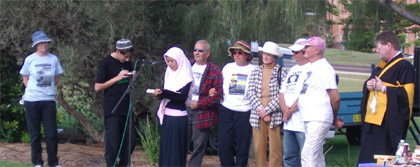


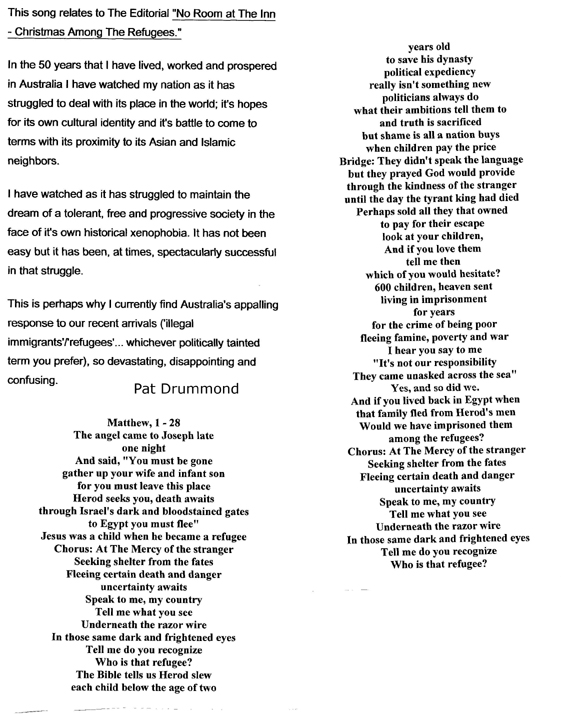
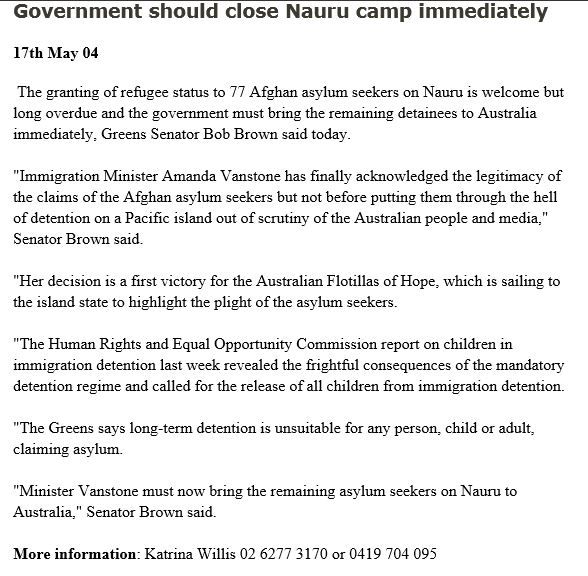
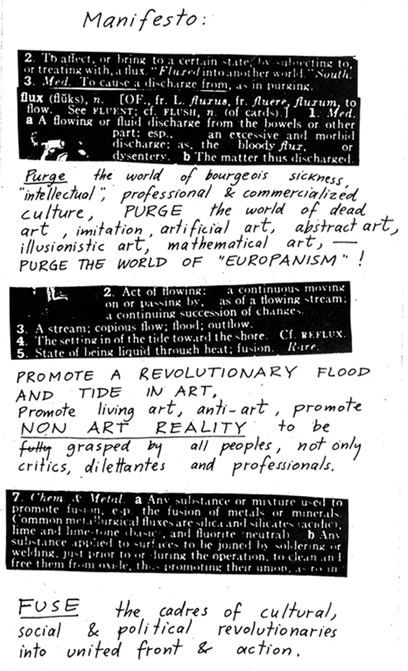



 Posted by stavr0s
Posted by stavr0s 